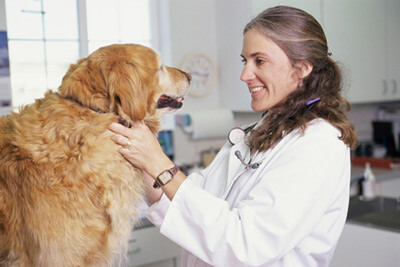Many of our pet owners have heard about laser therapy, but aren’t familiar with the many benefits of this procedure. At Animal Medical Center of Streetsboro, we use laser therapy to heal small cuts and to treat pain and swelling. Continue reading
Author: Animal Dogtor
Should I Choose Cryosurgery for My Dog?
If your dog is suffering from cancerous tumors or irritating skin growths, he may be a great candidate for cryosurgery. This effective, relatively painless procedure serves as a great alternative to treatments that may require long recovery periods and pose serious health risks.
What Does Cryosurgery Treat?

Cryosurgery, or cryotherapy, is a minimally invasive technique used to treat abnormal or diseased tissues such as skin tags, warts, infected or itchy lesions, cysts, and cancerous tumors on pets. Growths on the skin, in the perianal area, and mouth have all been successfully treated with cryosurgery.
Dog owners who feel that more traditional approaches are not suitable for their pets can opt for cryosurgery. Older dogs and those with medical conditions that prohibit surgery are great candidates for cryosurgery because the procedure and recovery are simple and quick, and the side effects are minimal.
Common Conditions Cryosurgery Is Used to Treat in Dogs
Veterinarians often recommend cryosurgery to address a variety of skin-related and surface-level conditions in dogs. Some of the most common include:
Skin Tags and Benign Growths: These are non-cancerous lumps or bumps that may appear due to age or genetics. While often harmless, they can become irritated, especially if located in areas prone to rubbing or scratching.
Papillomas (Warts): Common in younger dogs or those with compromised immune systems, these viral warts can spread easily. Cryosurgery effectively removes them without causing trauma to the surrounding skin.
Perianal Gland Tumors: These tumors, located near the anus, can be uncomfortable and may lead to infection. Cryotherapy is a less invasive alternative to surgical removal.
Cysts and Sebaceous Gland Tumors: These can rupture, become infected, or cause discomfort. Freezing them with cryogen offers a safe and effective solution.
Because cryosurgery is minimally invasive, it is often ideal for small, localized growths or lesions that don’t require extensive surgical excision. Many pet parents also appreciate that the procedure is less stressful for their dogs, especially those who are older or medically fragile.
How Does Cryosurgery Work?
Cryosurgery involves applying cryogen, or liquid nitrogen, to the area in question. The cryogen “freezes” the area, killing the abnormal cells and halting further growth. The cryogen is applied either as a spray or through a microneedle, both of which afford doctors excellent control over the application to target the affected area and preserve the surrounding skin. The frozen growth quickly turns red and blisters.
Within 2-3 weeks, a scab forms and falls off, revealing healthy, lesion-free tissue in its place. Local or general anesthesia may be necessary based on the location of the growth and temperament of the dog; however, there are cases in which no anesthesia is required.
How Effective is Cryosurgery?
In many instances, cryosurgery resolves tumor issues altogether, frequently after only one treatment. Small warts and tumors rarely recur, and cancerous mouth and nasal tumors often go into remission after a single treatment as well. Cryosurgery can also be used in conjunction with traditional surgery to improve overall results, target growths in difficult-to-reach areas, and reduce recovery time.
Benefits of Cryosurgery for Dogs:
- Minimal or no anesthesia is required
- Same-day, outpatient procedure
- Minimal pain/discomfort
- Simple recovery and aftercare
- Quick healing, no sutures
- Treats hard-to-reach/slow-healing areas
- Can be combined with conventional surgery
- Affordable
The Animal Medical Center of Streetsboro now offers cryosurgery with Cool Renewal® for pets. If you think your dog might benefit from this procedure, don’t hesitate to contact us at 330-249-7851 for more information or to schedule an appointment to have your dog evaluated for candidacy.
Aurora, Ohio
The city of Aurora, Ohio is a beautiful suburban area in northeast Ohio that is less than 45 minutes from Cleveland. With about 15,000 people living in the area, and more than 4,000 families, we have a close-knit community that supports all of its residents with a variety of services.
Community Resources in Aurora, OH
- Schools. The Aurora City School District has five schools, mostly in a campus setting, with around 3,000 students enrolled. Cleveland Magazine rates the district #10 out of 77 Northeast Ohio communities.
- Housing. There is ample housing in the Aurora, OH, area, including one, two, and three-bedroom townhomes with open floor plans, as well as new single-home housing plans that offer every amenity for families.
- Shopping and Restaurants. From outlets with hundreds of stores, to small shops that carry local goods, Aurora has something for everyone. Our local eateries have a variety of delicious foods and baked goods so come in and stay awhile!
- Parks and Recreation. Aurora has several parks that are great for families, a nature center, recreational sports leagues, and exercise and craft classes for both kids and adults, plus plenty of opportunities to attend community events. We also have best outdoor waterpark in northeast Ohio Wildwater Kingdom, which has water slides, a wave pool, lazy river, and special areas just for kids. Aurora also boasts a theater and library.
- Pet Services. Aurora has several pet-related services in the community, including kennels, and the Animal Medical Center of Streetsboro, which is a full-service animal hospital with two veterinarians on staff.
- Great Location. Aurora is only about 45 minutes from Cleveland, which has world-class entertainment and events. In the summer, everyone enjoys the banks of Lake Erie. You can catch the Cleveland Indians, Cavaliers, or Browns, visit the West Side Market, enjoy the Cleveland Aquarium, or have fun at the zoo. And don’t miss the Rock and Roll Hall of Fame it has hundreds of interactive music exhibits that teens and adults both enjoy.
Aurora, Ohio has many community resources, is in a convenient location, and is a great place to raise a family. Whether you live here or are coming for a visit, we hope that you enjoy your stay in northeast Ohio.
Five Pet Health Care Myths You Should Ignore
Pet Health Myths
You have probably heard lots of things about your pets that come from well-intentioned but misinformed people, and some of this advice can be quite harmful to your dog or cat. Here are some of the things that veterinarian and their staff hear most often from both pet owners and non-pet owners.
Myth 1: Dogs can mostly eat whatever people eat.
Your dog (and your cat, for that matter) should have a healthy diet that consists of protein, fat and carbohydrates that is delivered through quality pet food. What dogs need to stay healthy are not the same foods as what people should eat. If you’d like to feed your pets some of what we eat, stick to simple foods like cauliflower, small carrots, lettuce, pears and apples. Avoid raisins and grapes they are toxic to dogs. Cats shouldn’t be given milk, but many of them enjoy putting their paws in moving water.
Myth 2: Pets can get good dental care without using anesthesia.
You pet may be very calm, but no pet will be able to stay still long enough for a proper dental exam. Since animal medical centers clean both the exposed part of your pet’s teeth and the part that is above the gum line, your pet must be under anesthesia so that your veterinarian or assistant can do their part to keep your pet healthy.
Myth 3: Pets that spend all of their time indoors don’t need to see a veterinarian.
Even if your pets live in your house and never go out, they still need to be vaccinated. They may never be around other pets, but people can come into your house with germs clinging to them that can be passed along to your pet, possibly harming them and making them sick. It’s also a good idea to visit an animal medical center for grooming and dental care.
Myth 4: A little baking soda to brush your dog’s teeth is okay.
You shouldn’t brush your dog’s teeth with anything but specially-formulated dog toothpaste. Baking soda is too abrasive for your dog’s teeth. And of course, never use toothpaste on your pets that’s made for people.
Myth 5: Cats have nine lives
Of course, everyone knows that’s not true. But many people think that cats can always land on their feet. Cats are certainly curious, which leads them to visit around high places, but please remember that they can get injured just as easily as other pets.
The Animal Medical Center of Streetsboro believes in educating our clients so that their pets live long, happy, healthy lives. If you have any doubt about how to care for your pet, please give us a call. We’d love to help you truly understand your pet so that you can enjoy many years together.
What to Do When Your Pet Swallows a Foreign Object
Did Your Pet Swallow a Foreign Object?
Sometimes, your dog will eat something he or she shouldn’t. It can be while they’re chewing on something, or just because they eat whatever you have left out in your house or in your yard.
While some people smile at dogs being dogs, the truth is that your pet may swallow something that won’t pass right through his system. I’ve heard many stories about objects that dogs have eaten. This includes chew toys, stones, wood, string, crayons, and bones. There’s a good chance that you didn’t see your dog eat this object, and you may not know it’s happened until he begins reacting to it. You’ll need to bring your dog to an animal health center to remove any obstruction that may be harming your dog.
Signs That Your Dog Has Ingested a Foreign Object
You will notice that your dog:
- Is gagging or vomiting either sporadically or consistently
- Has diarrhea or mostly loose stools
- Doesn’t want to eat as much as she normally does
- Doesn’t want to be touched in the abdominal area either becomes aggressive or runs away
- Acts tired
- Has something hanging from either her mouth or her behind
- Has stopped producing stool
What Kind of Damage Can a Foreign Object Do to Your Dog?
If your dog has ingested something harmful, it could cause a great deal of damage to your pet’s intestines by obstructing parts of the bowel or by interfering with your dog’s blood supply to the small or large intestines.
If you notice the above symptoms, call the Animal Medical Center of Streetsboro. Dr. Leffler will examine your dog, ask you questions about your dog’s recent behavior and symptoms, and possibly order an ultrasound and x-rays to determine if a foreign object is indeed lodged in your animal’s intestines or stomach. Depending on where the object is, how big it is, what it appears to be, and your dog’s overall health, we may need to remove the object through surgery.
Dr. Leffler urges you to call the Animal Medical Center of Streetsboro if you suspect that your dog has swallowed an object. We can examine your dog right away and determine the next steps so that your pet will be healthy. Call us today at 330-626-4935.
How to Prevent Ticks in Dogs
Preventing Dog Ticks
It’s summer, which means that your dog is more likely to get ticks, and the tick-borne diseases that they often carry. In Ohio, especially in the Akron Canton area, we are seeing growing numbers of black-legged ticks, which can carry Lyme Disease, and there are also many American dog ticks and lone star ticks in this area. Dogs that get tick bites can also suffer from anemia, skin infection, or tick paralysis. Be sure that you protect yourself and your pets from these dangerous pests.
What Should I Do to Protect My Pet and Myself?
- Tick are very small as small as a sesame seed so you may not know that your pet has ticks until as long as three weeks after a bite. You should examine your dog every day or so to look for signs especially if they have been outside during the day.
- If your yard is hospitable to ticks, remove that habitat. This includes brush, shrubbery, bushes, and leaf piles. If you walk your dog in woods or high-grassed areas, be aware that ticks can be found there. Better yet, keep them in well-mowed areas during the spring and summer.
- Be sure that your veterinarian performs a tick check on your pet when they are there for a regular appointment.
- Tick-proof your pets! Use a medication that is meant for tick prevention, such as Frontline Plus, which kills all major ticks, including the ticks that carry Lyme disease.
What Should I Do If I Find a Tick on My Dog?
Ticks must be removed before they transmit disease. You can remove one by:
- Taking a pair of tweezers and grasping the body firmly, close to your dog’s skin. Pull the tick straight up without twisting, since this may leave the mouth in your dog’s body.
- Don’t crush the tick or hold a flame to your dog to destroy it, because the tick may burst, further spreading disease.
- Use a disinfectant like rubbing alcohol to clean the bite site. If you notice a rash up to three weeks later, call your veterinarian.
If you live in the Akron-Canton area and your dog is having trouble with ticks, bring him or her in to the Animal Medical Center of Streetsboro. Call us today to set up an appointment.




